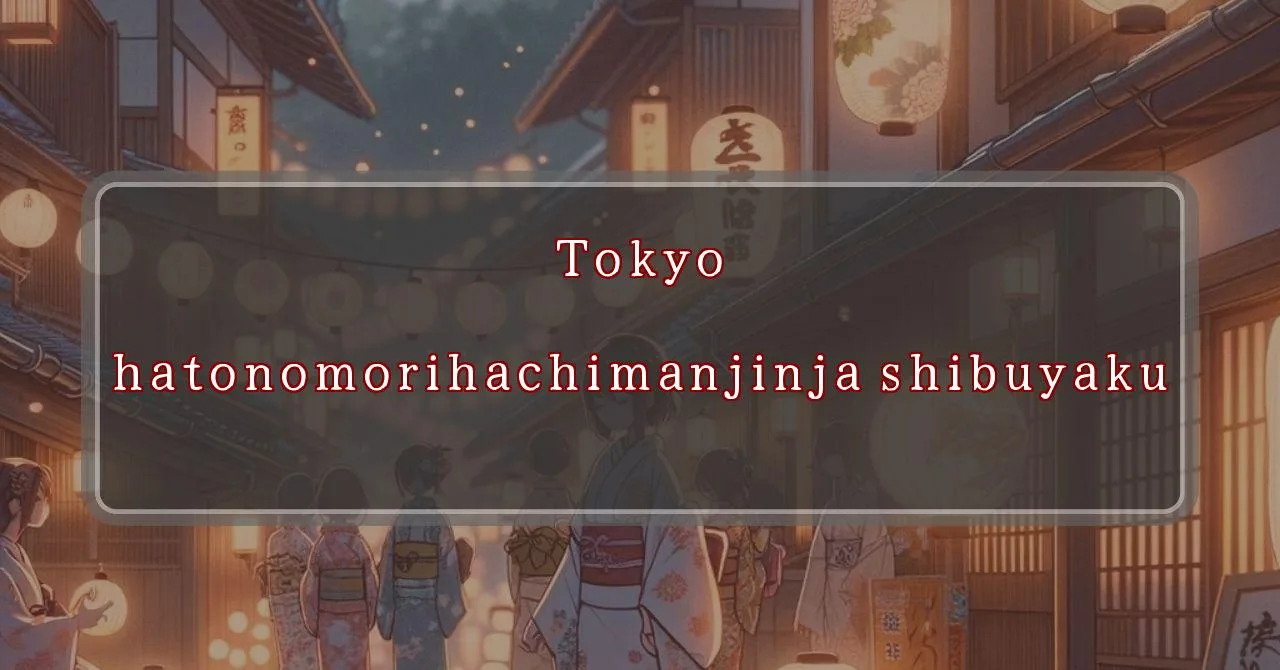Enchanting shrine festival in Tokyo, a fusion of tradition and modern charm
Basic Information
Hatonomori Hachiman Shrine is a Shinto shrine located in Sendagaya, Shibuya, Tokyo, Japan. It is dedicated to the deities Hachiman, the god of war, and his wife Himegami, the goddess of beauty and good fortune.
- Address: 1-1-24 Sendagaya, Shibuya-ku, Tokyo 151-0051
- Phone Number: 03-3401-1284
- Access: 5-minute walk from Sendagaya Station on the JR Sobu Line, Tokyo Metro Fukutoshin Line, and Keio New Line.
- Festival Days: September 9th (Sat) and 10th (Sun), 2024
Main Events and Attractions of the Festival
The Hatonomori Hachiman Shrine Festival is a two-day festival held annually in September. The festival features a variety of events and attractions, including:
Mikoshi Procession
The highlight of the festival is the mikoshi procession, which takes place on the second day of the festival. Eight mikoshi (portable shrines) are carried through the streets of Sendagaya by local residents. The procession is accompanied by music and dancing, and it is a lively and colorful spectacle.
Kagura Performance
Kagura is a traditional Japanese Shinto dance and music performance. It is often performed at festivals and other special occasions. At the Hatonomori Hachiman Shrine Festival, kagura is performed by local children. The performance is a beautiful and moving way to learn about Japanese culture.
Bon Odori Dance
Bon Odori is a traditional Japanese folk dance that is performed during the Obon festival, which is a time to honor the spirits of the dead. At the Hatonomori Hachiman Shrine Festival, Bon Odori is performed by local residents and visitors alike. The dance is a fun and lively way to experience Japanese culture.
Food Stalls
A variety of food stalls are set up at the festival, selling a variety of Japanese dishes, such as yakitori (grilled chicken skewers), takoyaki (octopus balls), and taiyaki (fish-shaped cakes). There are also a number of stalls selling souvenirs and crafts.
Fireworks Display
The festival concludes with a fireworks display on the evening of the second day. The fireworks are launched from a nearby park, and they light up the night sky with their brilliant colors.
Blessings and Deities
Hatonomori Hachiman Shrine is dedicated to the deities Hachiman, the god of war, and his wife Himegami, the goddess of beauty and good fortune. Hachiman is one of the most popular deities in Japan, and he is often worshipped for success in battle, business, and politics. Himegami is also a popular deity, and she is often worshipped for beauty, good luck, and fertility.
- Hachiman: God of war, business, and politics
- Himegami: Goddess of beauty, good luck, and fertility
Origin and History
The origins of Hatonomori Hachiman Shrine are unclear, but it is believed to have been founded in the 9th century. The shrine was originally located in a different part of Sendagaya, but it was moved to its current location in 1624. The shrine was destroyed by fire in 1868, but it was rebuilt in 1874.
- Founded: 9th century
- Moved to current location: 1624
- Destroyed by fire: 1868
- Rebuilt: 1874
Tips and Notes for Visitors
Here are some tips and notes for visitors to Hatonomori Hachiman Shrine:
- Hours: The shrine is open from 9:00 AM to 5:00 PM every day.
- Admission: Admission to the shrine is free.
- Dress code: There is no specific dress code for visiting the shrine, but it is considered respectful to dress modestly.
- Photography: Photography is allowed inside the shrine, but it is prohibited to take pictures of the honden (main shrine building).
- Parking: There is no parking lot at the shrine, but there are several coin-operated parking lots nearby.
Parking Information
There is no parking lot at Hatonomori Hachiman Shrine, but there are several coin-operated parking lots nearby. Here are some of the closest parking lots:
- Sendagaya Parking Lot: This parking lot is located a 2-minute walk from the shrine. It has 30 spaces and is open 24 hours a day.
- Times Sendagaya Parking Lot: This parking lot is located a 3-minute walk from the shrine. It has 50 spaces and is open 24 hours a day.
- Park & Ride Sendagaya: This parking lot is located a 5-minute walk from the shrine. It has 100 spaces and is open 24 hours a day.
Popular Stalls and Food Carts in Recent Years
| Type of Stall | Description |
|---|---|
| Takoyaki | A staple at Japanese festivals. Characterized by a crispy outside and a creamy inside. |
| Jaga Butter | A simple yet popular snack of hot potatoes lavishly topped with melted butter. |
| Baby Castella | Small castella cakes, sweet and fluffy treats enjoyed by children and adults alike. |
| Grilled Ayu with Salt | Fresh ayu fish grilled whole with salt, a savory taste of Japanese summer. |
| Shaapin | A unique gourmet item influenced by foreign cuisine, with a chewy skin wrapping the filling. |
| Okonomiyaki | A Japanese grilled dish where you often choose your own ingredients for a personalized flavor. |
| Cotton Candy | A fluffy, sweet snack that’s extremely popular with children. |
| Chocolate Banana | A banana coated in chocolate, a fun and visually appealing dessert. |
| Kushiyaki | Various types of ingredients skewered and grilled, an easy-to-enjoy snack. |
| Yakisoba | Fried noodles mixed with a special sauce, a fast food favorite in Japan. |



